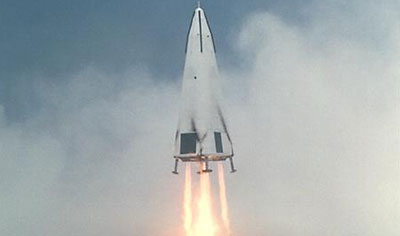Missile defense, RLVs, and the future of American spacepowerby Taylor Dinerman
|
| “Smart Rocks,” based in LEO, were among the “Star Wars” weapons the Soviets feared most. |
Smart Rocks evolved into “Brilliant Peebles” and these were to be the cornerstone of President George H.W. Bush’s planned Global Protection Against Limited Strikes (GPALS) system. One of the first acts of the Clinton Administration was to cancel the whole program. As Defense Secretary Les Aspin put it, “we’re taking the stars out of Star Wars.”
During the next eight years, the Clinton Administration spent billions on weapons whose primary purpose was to fight gravity rather than to shoot down missiles. Against tactical missiles, they developed the PAC-3 version of the Patriot and the Lockheed Martin THAAD. They also continued the effort begun under Ronald Reagan to help Israel build the Arrow, which, in conjunction with the PAC-2 version of the Patriot, gives Israel the only multi-layered missile defense system in the Western world.
The Clinton Administration failed to adequately fund any of the space elements of their system. In the late 1990s, they were touting SBIRS (Space Based Infrared System). This was supposed to replace the venerable DSP (Defense Support System) satellites that had been watching out for missile launches since the earliest example was launched in November 1970. Lack of funding and mismanagement has lead to a radical reduction its capabilities. Since the DSPs are coming to the end of their useful lives SBIRS is needed more urgently than ever.
The high cost of space access
The DSPs, along with the GPS navigation system, the military communication satellites and the spy satellites, together make up the core of today’s American military spacepower. These are all highly advanced and complex spacecraft that altogether cost billions to build and more billions to launch.
As a rule of thumb, it costs up to $10,000 dollars to put a single pound of payload, be it a satellite or food for the astronauts on the space station or anything else in LEO. The cost of a single launch can be anywhere from $20 million for an Orbital Sciences Corporation Pegasus to upwards of $500 million for a Shuttle launch, depending on how the cost is calculated.
Calculating launch costs and figuring out how much governments and companies actually pay to put payloads into orbit is a swamp full of secrets and misinformation. For example, the first launch of Lockheed Martin’s new Atlas 5 rocket carried a European commercial communications satellite. Rumor had it that they paid less than $25 million. The true cost was more than twice that. The first launch of any new rocket is risky and few companies will want to put their very expensive new spacecraft on an untried launch vehicle.
Even relatively well-proven rockets are often priced below cost. The services of the European Ariane 5 rocket are probably being sold at heavily subsidized prices. European taxpayers were recently asked to cough up more that $1 billion dollars to fix the flaws in the advanced version of this launcher. One was destroyed shortly after launch in December 2002.
| Making expendable rockets efficient and cost-effective is like trying to make a Ferrari cost-effective. They are intricate and delicate machines that are thrown away after a single use. |
The Chinese have been out of the commercial space launch business ever since they were caught taking proprietary information from Loral and Hughes after the 1996 crash of one of their rockets. The information they stole on satellite deployment systems could give them a shortcut to developing MIRVs for their nuclear missiles. While America has a formal ban on launching US-made satellites using Chinese rockets, other nations seem to have imposed their own informal ban on doing business with Beijing.
Countries such as China and France will continue to subsidize their rocket industries because they see independent access to LEO as a vital military capability. They also know that by developing expertise in designing launch vehicles they are also increasing their skills in the long-range nuclear missile area. As any space expert will be glad to explain, a space launch vehicle is nothing but a glorified artillery shell, directly descended from the V-2 which the German Nazis used to attack London and Antwerp in 1944-1945.
Making such rockets efficient and cost-effective is like trying to make a Ferrari cost-effective. They are intricate and delicate machines that are thrown away after a single use. The Shuttle, which NASA described as a first-generation reusable launch vehicle (RLV), has to be practically rebuilt from scratch after each mission. No dramatic reduction in launch costs is possible as long as cargo and passengers have to ride into space on what one expert called “disintegrating totem poles.”
